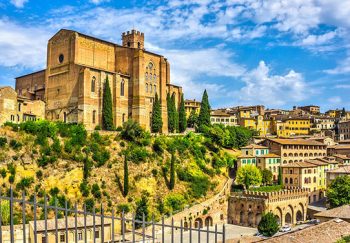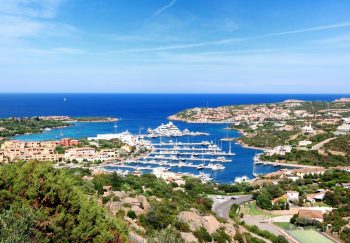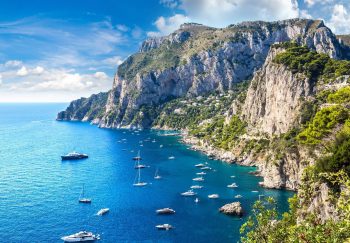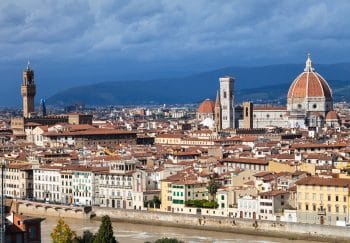The Florence Cathedral is often called “both birthplace and proving grounds of the Renaissance”. It is the most important structure in Florence and, indeed, the most important in the world.
Many men worked over many years to build the Florence Cathedral. They rediscovered lost knowledge, created new painting techniques, and competed fiercely amongst themselves to create one of the most unlikely stories in architecture history.
Although the Florence Cathedral may not be the most impressive or beautiful, its vast knowledge makes it unique.
The Florence Cathedral: What should you see?
The Dome
The Dome of the Florence Cathedral was the world’s largest for 500 years, until the modern era. It is still the largest brick dome in existence and the story of its construction is fascinating. (To learn more, visit our post on the 7 Amazing Things You Didn’t Know About The Florence Duomo).
Filippo Brunelleschi built it by literally regaining architectural knowledge that was lost since antiquity. Brunelleschi made the cathedral’s roof the most impressive in the world by meticulously studying Roman ruins and using his own calculations. It is a monument to human accomplishment and the intellectual and aesthetic forces that led to the Renaissance.
The Florence Cathedral was built in 1296. It was completed almost entirely in 100 years. The project’s supervisors knew exactly what they wanted: the largest dome in the entire world. But the problem was actually building it.
This was especially frustrating because the rest was already built. They had to either live up to their ambitions or endure a church that was open to all the elements 24/7. They had to build the largest building the world has ever seen. They held a competition, as all Renaissance Italians do in times of doubt.
Filippo Brunelleschi is the diminutive hero in our story. He was described by Giorgio Vasari, the Art Historian, as “small and insignificant” but he is “a person with spirits so full of greatness, and hearts so boundless that they can never rest until they complete difficult and nearly impossible tasks.
Brunelleschi had already “discovered” linear perspective rules and spent several years studying ancient Rome ruins with Donatello to learn old design techniques that were long lost. The competition presented him with a design that seemed to solve all of his problems. He was reluctant to reveal the details of his design, fearing that it might be stolen.
He would make two domes and place them inside each other, much like a Russian doll. To ensure greater structural strength, the walls would be enclosed in tension rings similar to the rings on a barrel. Bricks would also be arranged in herringbone patterns.
He created special scaffolds to prevent his workers from falling and invented a new lifting mechanism to lift building materials off the ground. He also feuded bitterly with Lorenzo Ghiberti who had defeated him in the previous competition to design the doors to the Florence Baptistery.
The project was completed on March 25, 1436. Pope Eugenius IV consecrated it, the cathedral now having the largest Dome in the world. You can climb all the way up to the top of the cathedral to see the city, but the real wonder is right below your feet.
The VIP Florence duomo gives you exclusive access to Cathedral, Terraces & Dome Climb. This allows you to gain access to areas that are otherwise closed to the public.
The funerary Monument to Sir John Hawkwood
The funerary monument, which is actually a fresco as you might have noticed, is an intriguing piece of art for more than what it does. It doesn’t correctly use perspective. The horse and rider appear from one angle, while the pedestal on which they are standing appears from another.
Although mathematically-determined linear perspective would have been known to the artist, Paolo Uccello, he wasn’t able to employ it properly in the painting. The mistake is not too tragic, considering that the subject was a rather unsavory mercenary who traveled around Europe riding, or not fighting, for anyone who would pay him enough money.
The Original Facade and Penitent Magdalene. Michelangelo’s other Pieta
Many people are unaware that the facade of Florence Cathedral was not originally designed by Arnolfo Di Cambio, the Cathedral’s principal architect. He created a beautiful font piece that featured works by Donatello, Nanni di Branco and others.
It was not finished because he died before it could be completed. After some historical detective work, the Duomo Museum curators and artisans have managed to rebuild the facade. They have now put it on display at the Museum. It is located across from Ghiberti’s original baptistery doors in their original orientation. The ones that everyone touches and crowds around are copies.
Thirty years of penitence is enough to destroy anyone’s skin. Donatello’s Penitent Magdalene (Maddalena penitente) is a good example. But don’t think we didn’t warn. This wood sculpture is one the most bizarre and realistic images of the Renaissance. It depicts the most famous prostitute in the Bible, drawn, emaciated and ravaged by nature. It is absolutely compelling.
You don’t need to look far for pathos if you’re looking for art that fails, Michelangelo’s incomplete Pieta. It was to be a sculpture that would look like his masterpiece at St. Peter’s Cathedral, but it would instead of being a decoration for a church, but would sit on top of his tomb. Michelangelo, a notorious perfectionist and perfectionist, eventually became unhappy with how it was turning out and used a hammer.
You rarely get to see the flaws of a great mind. But this sculpture gives you that rare opportunity. The Grand Museo del Duomo houses Pieta and the Penitent Magdalene.
The Baptistery doors
It’s easy to forget that Lorenzo Ghiberti, despite all his frustration with Brunelleschi over the Duomo’s construction, was a master of his craft. He was actually one of the most important artists of the Italian Renaissance. It was his commission for two of his masterpieces, the Florence Baptistery Door and the Florence Baptistery Doors that set off his feud with Brunelleschi.
Two sets of doors were actually made by him, one depicting scenes in the new testament, and another, more well-known, showing scenes from the Old Testament. Michelangelo called the second set, “Gates of Paradise”, because it is more naturalistic and uses perspective better. The Gates of Paradise currently occupy the baptistery, but they are actually replicas. You can only see the originals at the Duomo Museum.
Tips to Visit the Florence Cathedral
Opening Times
The Cathedral of Florence is actually split into six parts: the Dome (the Dome), the Baptistry, The Bell Tower, The Crypt and the Dome. Each of these parts have a different opening time depending on the day of week, as Italy is.
The Duomo museum website offers an easy-to use calendar that allows you to see the hours for all 6 areas on any given day.
Tickets:
The Cathedral is open to all, with no need to queue. However, you can visit the Museum to view the works of art. To do this, climb up to the dome and enter the Baptistery. Tickets cost between EUR5 and EUR20. Children aged 7-14 years are eligible for a reduced entry fee and children younger than 7 are free. For more information on ticket prices, please visit the Duomo museum webpage.
Rules:
Please be aware that the digital Covid Health Certificate (or ‘Green Pass’) will now be required to visit the monuments.
At all times, appropriate clothing is required because the Cathedral complex is a place of worship. Both men and women must wear clothing that covers their shoulders, and skirts and shorts that extend past their knees. If you are not appropriately dressed, you will be denied admission.
The cathedral does not allow open food or drinks. Pets are not allowed. Cell phones must be switched off or turned to silent.
Photographs are permitted, but not without flash. No tripods or selfie sticks. You are not allowed to bring a large bag into Florence’s museums. You are not allowed to bring a large suitcase into the museum, unlike many others.
The Best Times to See Florence Cathedral
The Florence Cathedral is the most popular tourist attraction in Italy during high season (roughly May to September). It has a wait time of approximately two hours for entry and two hours for the climb to the top.
It’s important to note that the museum can be accessed from any day of week, and the line for entry to the bell tower is shorter than for the dome climb. The bell tower is 414 steps high, while the dome climb has 463. Both have no elevators. To climb such heights in the middle of summer in Italy, you need to be a strong soul and have strong legs.











